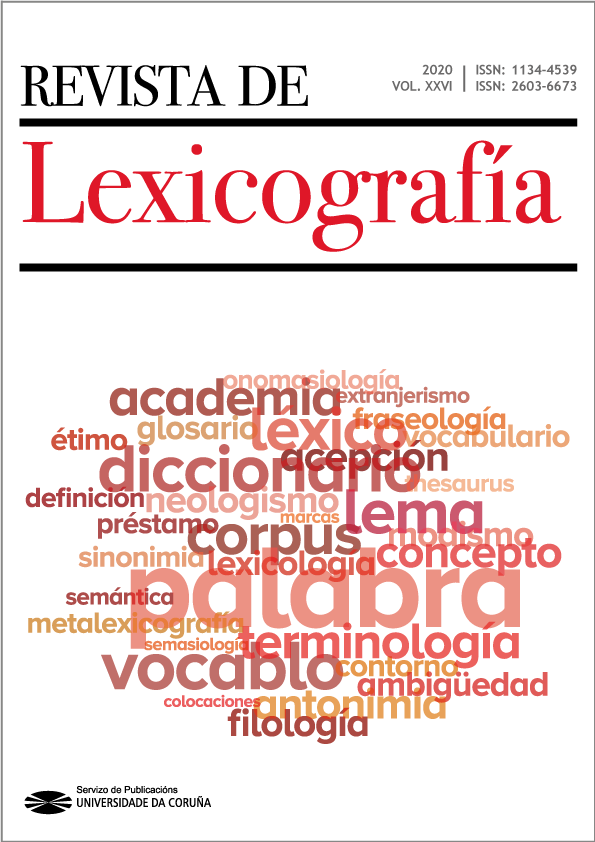Old Spanish recudir and the verb acudir. An example of cognitive diachronic semantics
Main Article Content
Abstract
The article deals with the medieval Spanish verb recudir and its modern follower acudir. The method used is the one that derives from cognitive diachronic semantics. The verb recudir was a deictic verb indicating a movement with implied direction, movement backwards with a prospective dimension behind. From the thirteenth century a second prototype appears with a change in deictic signaling and a change in prospective direction involved: the direction of movement is the opposite, forward with a prospective dimension ahead. Also in the thirteenth century a new lexeme appears, acudir, which continues the second prototype and which ends up replacing recudir. The new lexeme suffixes the preposition a-, which responds to the change in deictic signaling and the change in the prospective direction implied by the second prototype.
Keywords:
Downloads
Article Details
References
Buck, Carl Darling (1971): A dictionary of selected synonyms in the principal indoeuropean languages. A contribution to the history of ideas, Chicago-London, The University of Chicago Press.
Chantraine, Pierre (1990): Dictionnaire étymologique de la langue grecque. Histoire des mots, Paris, Klincksieck, 2 vols.
Cifuentes Honrubia, José Luis (1989): Lengua y espacio. Introducción al problema de la deíxis en español, Alicante, Universidad de Alicante.
Cifuentes Honrubia, José Luis (2009): «Verbos deícticos con dirección implicada», en José Luis Arráez Llobregat, Carmen Ramón Díaz y Ángeles Sirvent Ramos, eds., Del saber a la vida. Ensayos en homenaje al profesor Francisco Ramón Trives, Alicante, Universitat d’Alacant, pp. 113-123.
CORDE = Real Academia Española: Banco de datos (CORDE) [en línea]. Corpus diacrónico del español. <http://www.rae.es>.
Cuervo, Rufino José (1998): Diccionario de construcción y régimen de la lengua castellana, Barcelona, Herder, 8 vols.
DHLE = Real Academia Española: Diccionario Histórico de la lengua española (1960-1996), Madrid, Imprenta Aguirre. T. I: A-alá. 1960-1972 (fasc. 1-19) - T. II: Álaba-antígrafo. 1974-1992 (fasc. 11-20) - T. III: Antigramatical-apasanca. 1993-1996 (2 fasc.) - T. IV: B-bajoca. 1996 (1 fasc.).
Ernout, Alfred y Antoine Meillet (1994): Dictionnaire étymologique de la langue latine, Paris, Klincksieck.
Evans, Vyvyan (2007): A glossary of cognitives linguistics, Salt Lake City, Edinburgh University Press.
FEW = Von Wartburg, Walter (1922-2002): Französisches etymologisches Wörterbuch, Bonn-Aarau-Leipzig-Bâle, Klopp-Teubner-Zbinden, 25 vols.
Geeraerts, Dirk (1997): Diachronic Prototype Semantics. A contribution to Historical Lexicology, Oxford, Clarendon Press.
Geeraerts, Dirk (2006): «Cognitive grammar and the history of lexical semantics», en Words and other wonders. papers on lexical and semantic topics, Berlin-New York, Mouton de Gruyter, pp. 367-397.
Geeraerts, Dirk (2010): Theories of Lexical Semantics, Oxford, Oxford University Press.
Kasten, Lloyd y Florian Cody (2001): Tentative Dictionary of Medieval Spanish, New York, The Hispanic Seminary of Medieval Studies.
Kasten, Lloyd y John Nitti (2002): Diccionario de la prosa castellana del rey Alfonso X, New York, The Hispanic Seminary of Medieval Studies, 3 vols.
Malkiel, Yakov (1946): «The Word Family of Old Spanish recudir», Hispanic Review, 14, 2, pp. 104-159.
Müller, Bodo (1987-): Diccionario del español medieval, Heidelberg, Carl Winter.
Newman, John (1996): Give. A cognitive linguistic study, Berlin-New York, Mouton de Gruyter.
REW = Meyer-Lübke, Wilhelm (1972): Romanisches Etymologisches Wörterbuch, Heidelberg, Carl Winter.
Sánchez, María Nieves (2000): Diccionario español de documentos alfonsíes, Madrid, Arco/Libros.
Skeat, Walter (1974): An etymological dictionary of the english language, Oxford, Oxford University Press.


